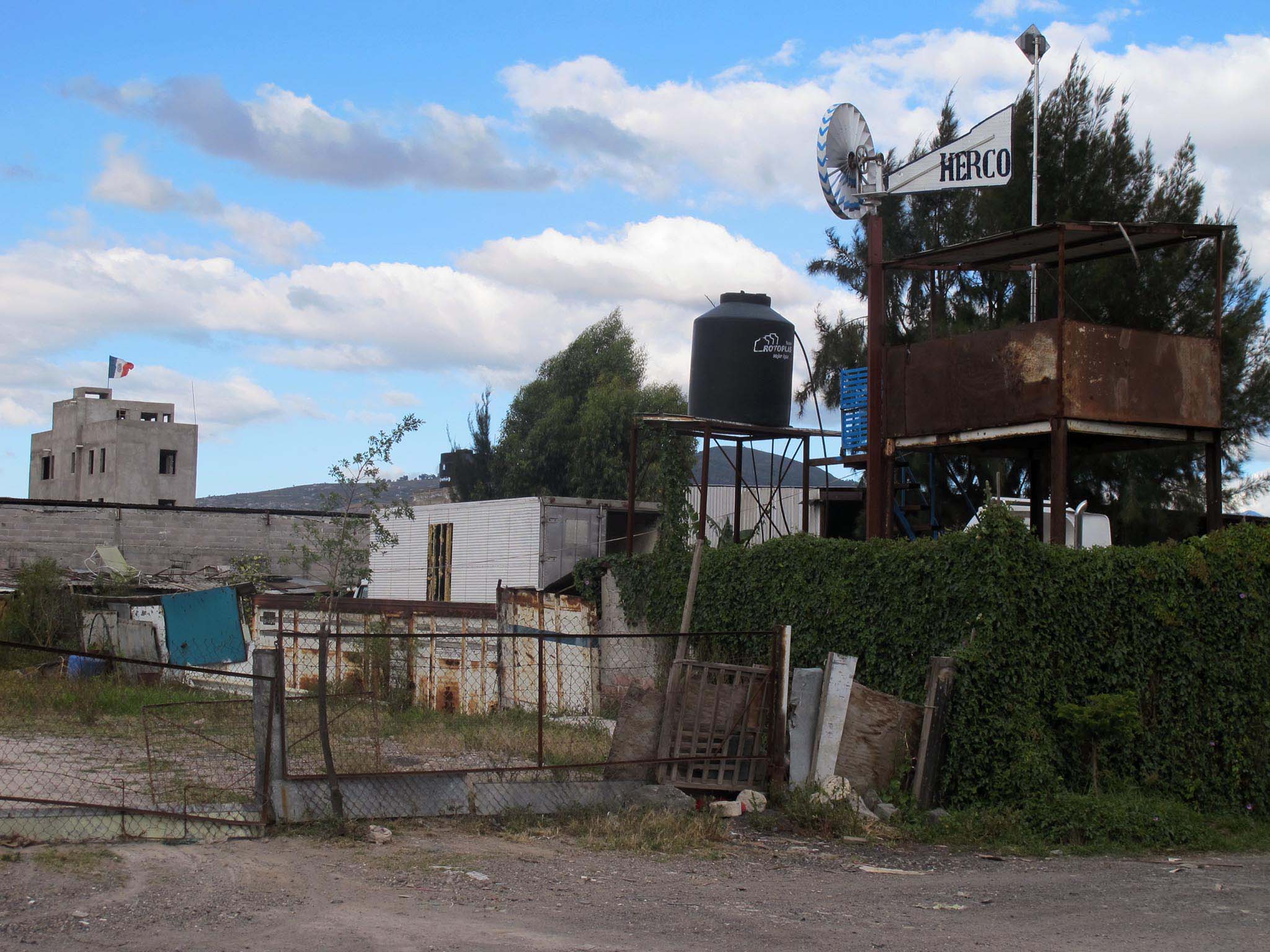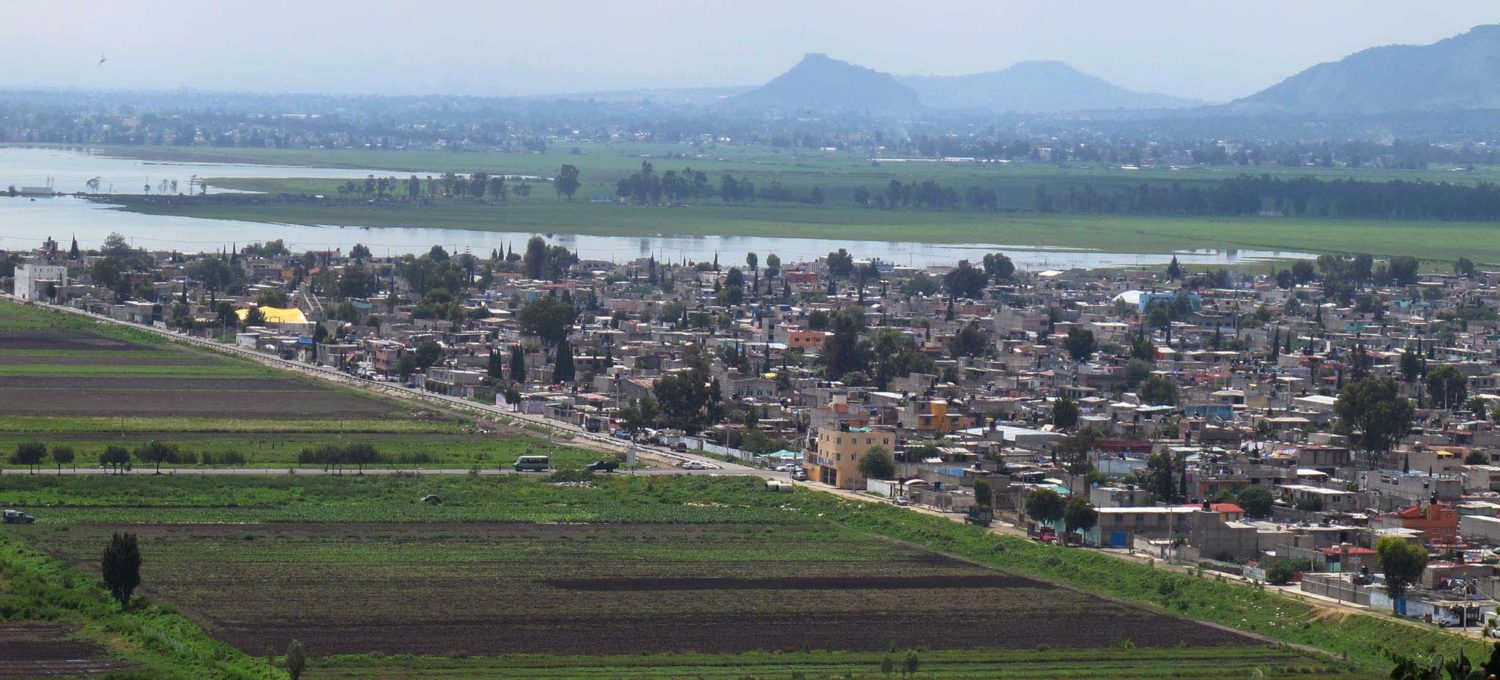Wandering along the flat, swampy, edges of Lake Chalco, I saw a teenage girl perched on the wall of her house. She held cables in her hands and was connecting what was called a diablito to the power lines above her to tap off electricity. A boy on a bicycle stood under her along the dirt road. She was shockingly beautiful. Like a young Sofia Loren and briefly I felt I was in some movie by Fellini, a fairytale involving girls and walls and electricity cables and swamps. Her mother came out. She in turn was one of the most ugly women I had ever seen, with her toad mouth and wide face. Yet mother and daughter looked so much alike, separated by age alone.
The swamp seemed to attract shanties made of cardboard and corrugated steel. But on closer inspection I saw that many of them were storage sheds rather than actual houses for living. But the muddy streets around the houses with puddles and shrubs created a sufficiently threadbare environment. Electricity towers left odd open spaces of low shrubbery and grass beneath trailing under the towers and forming vast avenues of space. The girl’s mother told me that a few days before a body had been found just around the corner. A taxi-driver earlier on the trip had told me that Valle de Chalco was probably the most dangerous place he knew of. In hindsight I don’t think he was right, but at the time I was scared as evening fell and I scrambled among the pools, mud and half-finished houses.
I directed myself to an organization of indigenous migrants. I had been told that Valle de Chalco was the municipality in Mexico with the greatest number of spoken languages due to settlement by poor rural migrants from throughout the country. I wanted to get in touch with some indigenous people while I was there. As night fell I called a number a friend had given me. I asked for Juan Martínez but the secretary said he wasn’t in. I continued my walk away from the lake’s edge towards the center of the municipality where I was told the organization offices were. Night was falling and I was afraid.
Indigenous leader Juan Martínez was somewhat bemused by the arrival of a foreigner at his offices, a two story building with an Internet café on the bottom floor and offices above. Martínez, jet-black hair, a little bit chubby, in his mid forties, was suspicious of me. He explained that everywhere in the world people such as myself, light-skinned from first world countries, did everything they could to destroy the lives and culture of indigenous people such as himself. I was somewhat taken aback by this perspective, though I had to agree he was right at a certain scale of space and time. I did however ensure him that if there was any more general conspiracy involved I had not been informed.
A friend of his was also in the empty office, a bare large space with a glass window that looked out on a recording studio for an indigenous language radio station. Out came the mezcal and I was invited for a drink. I felt I was in some kind of strange job interview, since I was the one being asked all the questions. Where do you live? Do you have a family? How did you meet your wife? Would you like a little more mezcal? I was in the end a clumsy, awkward kind of spy and adventurer, frightened by the mere thought of being in Valle de Chalco.

After our convivial acquaintance I left through the night to my hotel accompanied by Juan’s friend over deserted railroad tracks and silent streets.
Late in the next afternoon we spoke again in his office, alone. He told me how he had become leader of the organization. It all started with six friends from the Mixe region of Oaxaca who liked indigenous dances. Juan was an accountant, one of those rare and invaluable people who likes forms and their orderly administration. He suggested that forming a NGO (asociación civil) would add seriousness to their project. This was the coincidence that started his career.
Electoral success in Mexico depends on the negotiation with popular organizations representing specific interest groups, such as indigenous organizations, street vendors and transport concessionaries. Typically the way for politicians to negotiate with special interest groups is to support their organizations financially, so that the organizations can pursue their member’s goals. In order for this to happen an organization must be formally constituted. Deposits from the government have to go to the bank account of some organization after all, or it would look funny. Supposedly during the nineties there were practically no formally constituted organizations in Valle de Chalco. Juan, as the only person who had done the paperwork for a civic association, suddenly found himself tapped as a political leader. And so he became a go-to person for political negotiation with indigenous migrants in Valle de Chalco on the basis of his interest in dancing and skills at paperwork.
According to Juan, 80% of the population of Valle de Chalco was indigenous, though even the most trustworthy sources will exaggerate the size of their political following. That is what political demonstrations are for in Mexico, so that these popular organizations can visibly show their numbers and electoral sway.
Walking the streets of Valle de Chalco, with its bicycle taxis, nightlife, tattoo parlors and supermarkets, I tried to see if there was anything particularly indigenous about this urban area. And in reality there wasn’t in the material culture. There was no way from walking into a shop you could tell that this neighborhood was composed of rural, indigenous migrants primarily from the south of Mexico. No typical restaurants. No particular building style. No special products. Perhaps the most important indicator of regional culture was the use of the Virgin of the Juquila from Oaxaca as a name for shops or as the centerpiece of an altar.
Indigenous people, especially from Oaxaca such as Juan, are present all over the edge of Mexico City. They sell typically Mexican cuisine such as carnitas and tamales. They wear western clothes. They have tattoos, fashionable haircuts and drink Coca-Cola. And it all kind of blends in.
Yet connections to the home villages are strong. With the purchase of a bus ticket a salesman in Mexico City can be a member at a meeting of village elders in Chiapas. The great demographic story of Mexico is that of indigenous migrants from the countryside arriving at the city over the course of centuries. Valle de Chalco is just another iteration of a very old theme. And though the material culture disappears, social structures, religious beliefs and the food stays the same.
I left Juan’s offices that night alone. As I walked into the streets of Valle de Chalco I no longer felt afraid, beginning to know where I was made all the difference. I bought some roast chicken in a stand and took a bite, holding a thigh in a plastic bag as I walked to the hotel. If this was the worst neighborhood I was to encounter then the whole trip might be feasible after all. I decided to stay another day.
